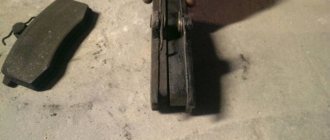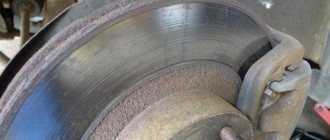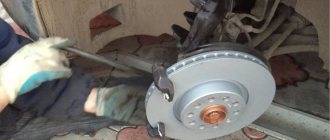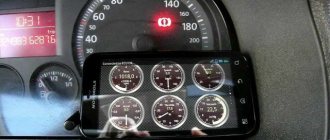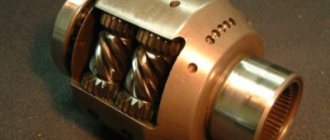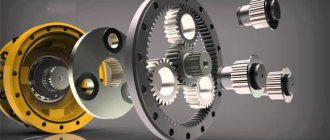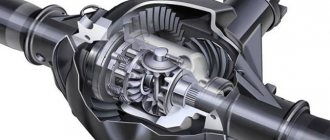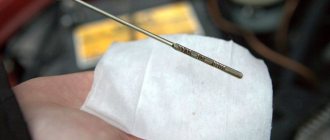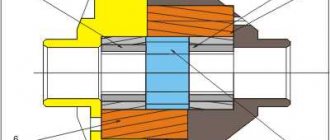Pads are one of the components of a car's braking system whose job is to slow down or stop the car using friction.
The driver, by pressing the brake pedal, creates brake fluid pressure in the contour pipes that are connected to the calipers. Calipers convert fluid pressure into mechanical movement by squeezing the brake pads between which the disc rotates.
The pads operate under conditions of strong compression, serious friction forces, sudden changes in temperature conditions and prolonged operation at high temperatures.
These elements of the brake system are subject to natural wear of the friction element - ferodo. The rate of wear is influenced by driving style, vehicle weight, as well as whether the brake system is working properly or not.
Purpose of pads
The brake system of new cars consists of two main components: discs and pads. Although most drivers go to auto mechanics whenever they feel something is wrong with their brakes, it would be nice to know some information. What do brake pads do, how do they work, and when is it time to replace them?
First of all, it's worth considering why pads are so important. Brake pads are an important component of the braking system because they provide the friction to stop or slow down your vehicle. When the driver applies the brakes, they press against the brake rotor, helping the car slow or stop, depending on the pressure.
As you can imagine, brake pads are constantly used and therefore wear out and require attention. They are components that need to be changed at certain intervals. This interval varies depending on how much the car is driven each day and how it does it. However, to find out the manufacturer's recommended time for replacing the pads, you should refer to the vehicle's technical manual.
Why do brake pads need to be replaced? Maintenance and timely replacement will help increase the level of vehicle safety. Periodic replacement of pads leads to increased service life of brake discs. You can also avoid more serious and costly vehicle breakdowns.
What should I do if the brake light on the instrument panel is on?
Checking the mechanical component
Self-diagnosis is a simple operation. It is divided into two components - mechanical and electrical. The first is very important, since it evaluates the condition of the brake system drive and determines its performance.
Checking the mechanical component is reduced to assessing the level of brake fluid in the reservoir and the condition of the drive lines and system components - the master brake cylinder and operating mechanisms.
The brake reservoir is located in the engine compartment, on the right near the rear panel of the engine compartment. It is not difficult to find it, since there are two wires going to the tank cap.
When checking, disconnect the wires and unscrew the cap to determine the brake fluid level. There are marks on the walls of the tank, by which you can understand how much liquid is left. A level above the middle between the marks is considered normal.
A drop below o indicates a fluid leak. Therefore, the next stage is checking the lines and brake mechanisms. To do this, inspect the wheels from the inside. If we find a fluid leak from the mechanisms, then we see smudges on the disks.
For an additional check, we start the car and press the brake pedal a couple of times, after which we roll the car back and inspect the surface of the ground for traces of leaking fluid, and check the fluid level. If it is detected, the brake line is damaged, and the amount of fluid will decrease.
If there is a brake fluid leak, the car cannot be used because the car does not have brakes. The best option in this case is to call a tow truck to deliver the car to the repair site. But if you have enough driving experience, then we get to the service station or garage on our own. Car brake systems usually have two circuits, and if the line of one of them is broken, the second continues to work. But due to the fact that the effectiveness of the brakes on a car with a damaged line is greatly reduced, you need to drive at low speed and with the hazard lights on.
Brake pad wear monitoring
Brake pads are considered consumables for a reason. They wear out and require replacement. The best way to find out if your brake pads need replacing is to look for a few symptoms.
In order to understand these symptoms, you must carefully read the information below:
1. Appearance. The surest way to find out if the pads need replacing is to look at them carefully. They are located directly behind the wheel, on both sides of the brake disc. The thickness of the pads must be at least 4 mm. If you find that the wear is significantly greater and the pads have become thinner, it is time to replace them. Today, most parts are equipped with a brake pad wear indicator. Thanks to these sensing elements, when the pads wear out and need to be replaced, the driver can hear a high-frequency squeaking sound.
2. Sound. Another symptom that your pads need to be replaced is the noise they make. When the brake pads wear out, the driver will hear a noise similar to two pieces of metal rubbing against each other. As mentioned above, today all cars are equipped with acoustic sensors that allow drivers to hear a sharp metallic noise. This means that the pads are worn out and should be replaced.
3. Feelings. The time when you need to replace your pads can be determined by how the brakes feel. If the driver feels jolts when braking and the brakes are no longer as effective as before, it would be a good idea to visit a car service center to check and, if necessary, replace the pads.
Even if the replacement is not a very difficult job, you should remember that safety is at stake, for which the car's brake components are responsible. That's why the best advice in this situation is to contact a specialist to replace the pads.
Replacing pads: about the regulations
Manufacturers do not have an exact answer to the question either. It all depends on how the car is used by the owner. With a moderate option, the standard service life reaches 40 thousand kilometers.
Rear pads have twice the service life. After all, the main load falls on the front part when braking occurs. 15 thousand kilometers is the service life for friction materials if the driving style is active.
If the indicator light starts to light up, experts do not recommend leaving the vehicle unattended for a long time. Rapid wear is typical for metal tips. You will have to change them too if other problems are not corrected in time. Otherwise, work is impossible.
Types of systems and operating principles
Sensors that warn of critical wear are divided into two types:
Mechanical.
Electronic.
The mechanical type is the simplest and at the same time effective sensor that monitors friction lining wear. Its design includes a plate mounted on the base of the block. The ends of the plate protrude beyond the limits of this pad and at the moment when the material wears away, the end begins to come into contact with the disk. This causes strange grinding sounds to appear. Unfortunately, today mechanical sensors are practically not installed on modern cars. The design, although simple, has its drawbacks. The first drawback is the high chance of losing the plate. The second “minus” is false positives, which in practice occur quite often. Sometimes, even recently installed pads begin to make squeaks, and the sensor begins to make a characteristic squeak. Also, a mechanical part cannot be placed on drum mechanisms due to the design features.
Electronic sensors are considered technologically advanced because they interact with the lamp on the instrument panel. The car owner does not need to listen to extraneous sounds. All information is sent to the sensor. It, in turn, is divided into external and integrated types.
The external type has a recess. It is placed on the block, namely on its metal part. The advantage of this type is that when replacing pads there is no need to change the sensor; it can simply be moved to a new part. Integrated devices are placed inside the pad, and it is impossible to remove it from there. When replacing the pads, the sensor also changes. This is quite easy to do.
How does a car's braking system work?
First, a little theory. The braking system is necessary in any vehicle to change the speed of the vehicle, perform maneuvers based on the situation on the road, and stop.
Despite the abundance of brands that the modern automotive industry offers consumers, the principle of its operation is the same for everyone. It consists of:
- pedals;
- master brake cylinder;
- connecting fittings (pipes);
- working cylinders located on both axes of the machine;
- amplifier
The driver, pressing the pedal in the cabin, exerts pressure through the piston of the master cylinder on the brake fluid, which enters the system. It acts on the working cylinders, which operate the braking devices.
When the pedal is released, the reverse operation occurs: the “brake fluid,” as drivers call it, returns to the main cylinder and reservoir, and the wheels become free.
Braking mechanisms
They are divided into two types: drum type and disk type. The first type was invented by the famous Frenchman Louis Renault, founder of the Renault brand, in 1902. In the same year, William Lanchester from the shores of Britain patented a disk system. It was not popular due to the terrible squeaking noise that the copper pads made when in contact with the disc.
The disc version in its modern form appeared much later: in 1953, they were installed on the Jaguar by British Girling.
Drum brakes. They consist of the drum itself, a metal bowl attached to the hub, one or two cylinders, springs, and pads. When you press the pedal, the latter diverge, press against the rounded surface of the drum, which rotates with the wheel, and braking occurs.
The entire load from the friction of the two components of the system falls on the friction linings, which are glued or riveted to the metal body of the pads.
Such mechanisms are considered less efficient in the modern automotive industry, so now they are installed mainly on commercial vehicles, on the rear wheels of some brands of passenger cars.
Disc brakes
The system consists of a perfectly smooth cast iron disc located on the hub, a caliper containing two pads, and one or two working cylinders. The caliper itself is attached directly to the car's suspension.
When braking, the device is driven by hydraulics, which ensures close contact between the friction linings of the pads and the disc.
What is the advantage of a disk system?
Let us explain why manufacturers of modern cars prefer such devices:
- More stable braking. The area of the contact spot in the drum form is larger than in the disk form. However, the pistons are not able to press the pads evenly, which affects the quality of the process. The pads in the system with the disc press it on both sides, ensuring quick stop of the wheel.
- Disc brakes are smaller in size and weight. The operating temperature is much lower. The ventilation holes in the disk and the small size of the contact area between the parts are to blame for this. As a result, they overheat less, making braking more effective.
- Friction linings are located inside the drum device. All dust from friction falls on the contacted surface, which also interferes with the high-quality deceleration of the car.
- Disc brakes are convenient: they are easier to maintain.
Modern industry produces regular and ventilated disks. The latter provide airflow through the holes, which allows to reduce the operating temperature. They are wider than usual in thickness, cost more, but have a longer service life.
Having understood the principle of operation of the system, let’s move on to the main topic of the review.
Consequences of pad wear
Having found out what the operating principle of the brake pad wear sensor is, the driver should study information about the safety of driving with worn elements. Parts that are not replaced on time lead to unpleasant consequences, and sometimes to an accident. The first signs of wear are expressed by the appearance of squeaks, vibration and an increase in braking distance.
Experienced drivers immediately notice how the pedal travel increases, the handbrake function worsens and the amount of “brake fluid” in the tank decreases. All these factors must be taken into account in order not to provoke bad consequences. Brake and wheel discs will begin to overheat and develop mechanical defects or rupture.
Fault diagnosis and repair
Drivers can independently diagnose brake pad sensors if they notice any malfunctions. An element can fail for various reasons. This usually occurs due to damaged or broken wires. The indicator light does not light up even if the pad wear is at its maximum. Another common reason is oxidation of the contacts in the area where the plug connects to the sensor. Oxidation occurs due to the ingress of water, which negatively affects the circuit resistance. Thus, the lamp lights up even if new pads are installed.
To fix the problem, you need to use a multimeter. If the wiring is “ok”, then you need to disconnect and clean the contacts, and then connect again. This method works if moisture and dirt get into the brake system.
If a false operation of the system occurs, the driver needs to eliminate moisture from the friction material and rubbing elements. You will have to check the repeated heating that occurs during braking.
What other features should be taken into account?
Metal components are added to the device to make it easier for it to pass electric current. At first the resistance appears strong; as the pads wear further, it decreases. This is the basic principle.
The sensors continue to perform their function even if they are damaged. They just switch to the mode of ordinary indicators, metal type. The metal core in any case forms friction, accompanied by a sound type in case of damage.
Failure of the sensors themselves is associated with a small amount of:
- The power wires, if damaged, are broken.
- Interaction with moisture, which leads to oxidation of contacts.
- Electrical circuit with damaged resistance. This happens if moisture gets on the internal parts. The result is false alarms of the lamps.
Is it possible to replace a faulty sensor?
You can replace the faulty part yourself, but you need to follow some recommendations. First, the car is raised with a jack and the wheel is unscrewed. The external sensor is located near the hub, mounted on a spring or clamp. The sensor is pulled out of its place, the contacts are cleaned of dust. Instead, another sensor is installed and the wheel is secured. After lowering the car “from a height”, it is worth checking the functionality of the element. The lamp lights up when the pads are very worn. A replacement sensor is selected that is similar to the old one, that is, the one recommended by the manufacturer. The work is carried out in accordance with the car repair instructions. Correct selection of parts makes driving safer.
